Aaron Levy: B2B Product Development
- Transfer

Stanford course CS183B: How to start a startup . Started in 2012 under the leadership of Peter Thiel. In the fall of 2014, a new series of lectures by leading entrepreneurs and experts of Y Combinator took place:
Second part of the course
First part of the course
- Sam Altman and Dustin Moskowitz: How and why to create a startup?
- Sam Altman: How to build a startup team and culture?
- Paul Graham: An Illogical Startup ;
- Adora Chung: Product and honesty curve ;
- Adora Chyung: Rapid startup growth ;
- Peter Thiel: Competition is the lot of the losers ;
- Peter Thiel: How to build a monopoly?
- Alex Schulz: Introduction to growth hacking [ 1 , 2 , 3 ];
- Kevin Hale: Subtleties in working with user experience [ 1 , 2 ];
- Stanley Tang and Walker Williams: Start Small ;
- Justin Kahn: How to work with specialized media?
- Andressen, Conway and Conrad: What the investor needs ;
- Andressen, Conway and Conrad: Seed Investment ;
- Andressen, Conway and Conrad: How to work with an investor ;
- Brian Chesky and Alfred Lin: What is the secret of company culture?
- Ben Silberman and the Collison Brothers: Nontrivial Aspects of Teamwork [ 1 , 2 ];
- Aaron Levy: B2B Product Development ;
- Reed Hoffman: About Leadership and Leaders ;
- Reed Hoffman: On Leaders and Their Qualities ;
- Keith Rabois: Project Management ;
- Keith Rabois: Startup Development ;
- Ben Horowitz: Dismissals, promotions and transfers ;
- Ben Horowitz: Career Tips, Westing and Options ;
- Emmett Shire: How to conduct interviews with users;
- Emmett Shire: How Twitch talks to users ;
- Hossein Rahman: How hardware products are designed at Jawbone;
- Hossein Rahman: The Design Process at Jawbone.
[Starts to play Eye of the Tiger ]
Aaron Levy: Maybe we’ll make it a little louder so that it “shakes” more? Yeah, that's better. Well, gentlemen, let's catch a beat and clap to the beat [audience laughter]. Well, that's enough, stop the music. Turn on the presentation, please. Thanks. It will be the most epic moment that the world of enterprise software has ever seen. It will be calmer further. Thank you for this well-rehearsed introduction.
My name is Aaron Levie and I am the CEO and Co-Founder of Box. Welcome to today's lecture on how to create an enterprise software company. This is my vision of the situation: will you choose the same path as me? Is he faithful? You decide.
So that’s what I’m doing today. I will try to convince you that all the previous speakers who spoke in this room are wrong and, in fact, you want to create a company that develops corporate software. I hope that we will go over the main points and you will understand why it's cool to work in this area, and also why the arguments in favor of working with b2c clients are so far from the truth and just ridiculous. Who wants to create an enterprise software company? Well okay. Thank you very much. I hope that when we vote at the end, the number of hands raised will not decrease. This is the only goal that I am pursuing today.
So, today we will talk about three things. First of all, I’ll quickly tell you how Box came about. Because at first we did not know that we wanted to create enterprise software. In this regard, I want to delve a little into the topic, and explain why we took this path, and what we are doing today.
Then we will talk about what has changed in the field of corporate development, and why it became possible to create startups in this area. Finally, we’ll look at the principles that make it possible to recognize how to build your own startup. I hope this will be useful in practice. I also apologize for my vote, I talked a lot over the past few days, I hope that I will be able to get to the third part and give a couple of practical tips.
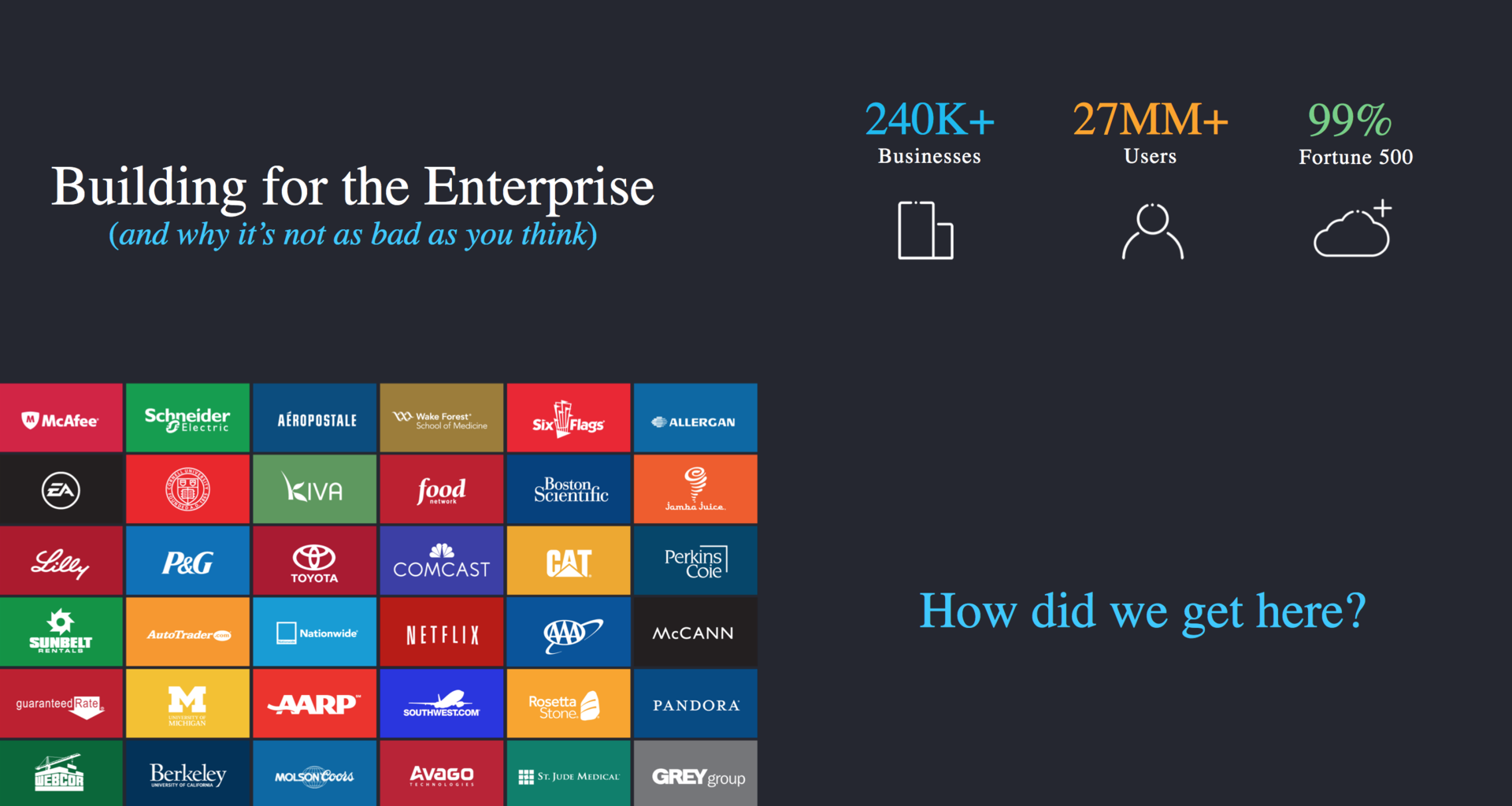
So, here are the general statistics on creating enterprise software in Box. Box is used by approximately 240 thousand companies, more than 27 million users contributed to the distribution of Box in their organizations, and this, in turn, accounts for 99% of Fortune 500 companies. The remaining 1% is Microsoft, and it seems to me that they don’t longing to buy our product. We need to work on this a bit.
Many people use Box in their workplaces, and here are some examples of such organizations [slide with tiles above]. Our product is used in a very wide range of industries: from consumer goods manufacturing to companies like General Electric. Stanford Health Care also uses Box to coordinate workflow in medical departments. Health care, the media, manufacturing - this is only a small part of the industries with which we work.
The question is, how did we come to this?
We did not conceive the company as a manufacturer of corporate software, it happened. We started the business in 2005, and the idea came to our mind in 2004, in college. Has anyone used the internet in 2004? Excellent. I did not know that the generation of "zero" used the Internet, so cool. Sorry, I won’t joke about age anymore.
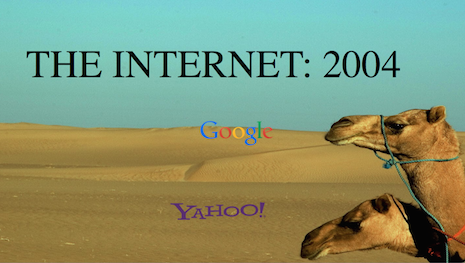
So, back to business. You may remember that at that time [on the Internet] there was nothing special to do. Boring little time, right? This is the time when there was no Facebook, Snapchat and many other services, for example, you could not exchange fifteen-second messages or photos with people, because you did not even have smartphones. Therefore, on the Internet in 2004, not much happened.
This is what the Internet looked like at that time: a deserted and deserted landscape [camel slide]. To clarify: a happy camel is Google, a sad one is Yahoo! .. This is what the Internet looked like in 2004. Yahoo! have done a great job since then, but then, in mid-2004, they were only trying to find their way. And Google has already taken over markets around the world.
And so, in 2004, in college, we noticed that for some reason it is very difficult to share files. Today it looks like the simplest task, and you go back 10 years, at that time it was either very expensive or it was very difficult to move data within the company. Then I did an internship at one of these companies, and most of my work was that I printed out the data on paper and distributed it to the offices. You did this as an intern if you were not from the faculty of computer science. I was a pro at copying paper, unfortunately this skill is not very useful today.
So, file sharing was problematic. In classrooms, students worked in large groups, and it was also difficult for them to share files. When I studied at the University of Southern California, we were given 50 MB of disk space. At 50 MB you can save one file, but they were deleted every 6 months. Whoever used IT at that time definitely did not use hard drives. That was the reality. And we thought: why do not we simplify the exchange of files and their storage, providing the opportunity to do this from anywhere on the planet?
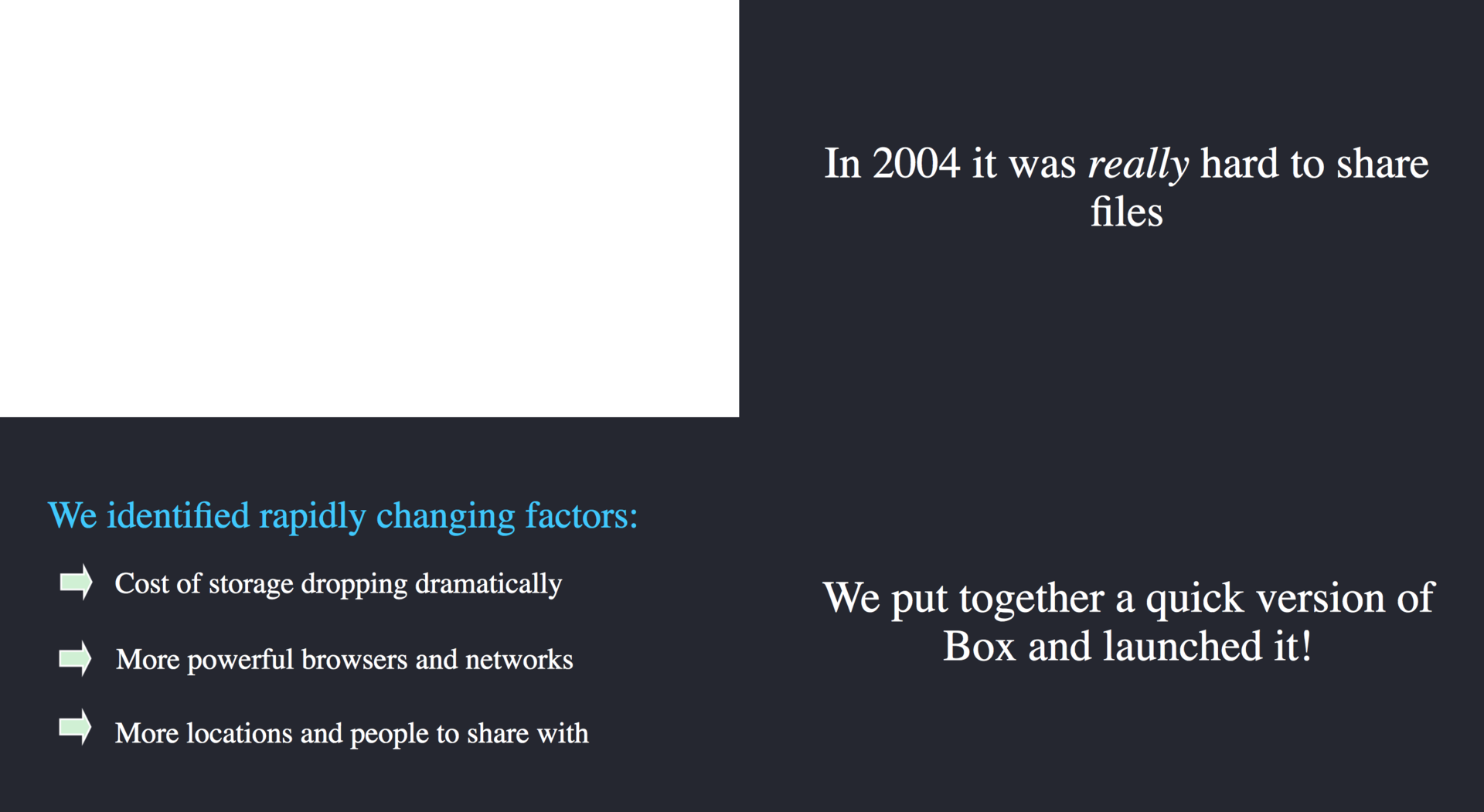
So the idea came to us, then Box.net. We were struck by the many changes that have taken place in the software world. First, the cost of storing information has dropped significantly. In our business, you can double the size of the information storage on your hard drive every year or two. What was previously unprofitable has become quite acceptable.
The cost of computing and the cost of storing information has decreased, we have more powerful browsers and networks. At that time, FireFox was just starting to emerge. Faster Internet appeared in people's homes and schools, and as a result, more use-cases appeared when people would like to store information and exchange it.
These three factors served as the starting point. Remember them, and I will give you some tactical advice .
First, always watch for changes in technological factors. Any market based on serious changes has always exposed these factors, which have significantly affected the state of things. We were very lucky with the growing need for data storage in the cloud, and the cost of creating such a service, on the contrary, decreased. We decided to whip up the first version of Box and launched it on Box.net. The idea was to simplify file sharing. And the idea "burned out", we received an angelic investment from a guy named Marc Cuban. This was before the Shark Tank, but it is very similar to it. We took the money and thought that everything would be very cool.

We were about to drop out of college and move to the San Francisco Bay area, we thought everything would be just fine. When you drop out of college ... has anyone dropped out of college already? OK I understood. Keep learning!
When someone drops out of college, he always draws a terrific future for himself. Bill Gates dropped out of college, so I will be like Bill Gates. Michael Dell also dropped out of college, so everything will be fine, just like Michael Dell. Steve Jobs dropped out of college ... these are the pictures that pop up in people's minds, but no one remembers this guy [photo on the slide in the lower right corner], and he dropped out of college too.
In fact, there is no guarantee that quitting college will make you successful. Funny, I'm not even sure that this guy really dropped out of college. He just looks like he had to. I apologize if someone knows him, this is just a funny picture from the Internet. So, we decided to leave college and moved first to Berkeley and then to Palo Alto. We decided to make the product free, as a result, the increase in users amounted to a thousand people per month. Starting to use Box.net, you get one gigabyte of disk space for free, which was quite a lot by the standards of 2006. But the influx of users was so great that I had to look for a way out of this situation.
What we are facing is a common problem, any startup has to deal with it. It was enshrined in our business model that we are building a very reliable and strong company for customers. But in fact, we created a trifle product. People starting to work with our service had the opportunity to connect paid features, but most users did not need them.
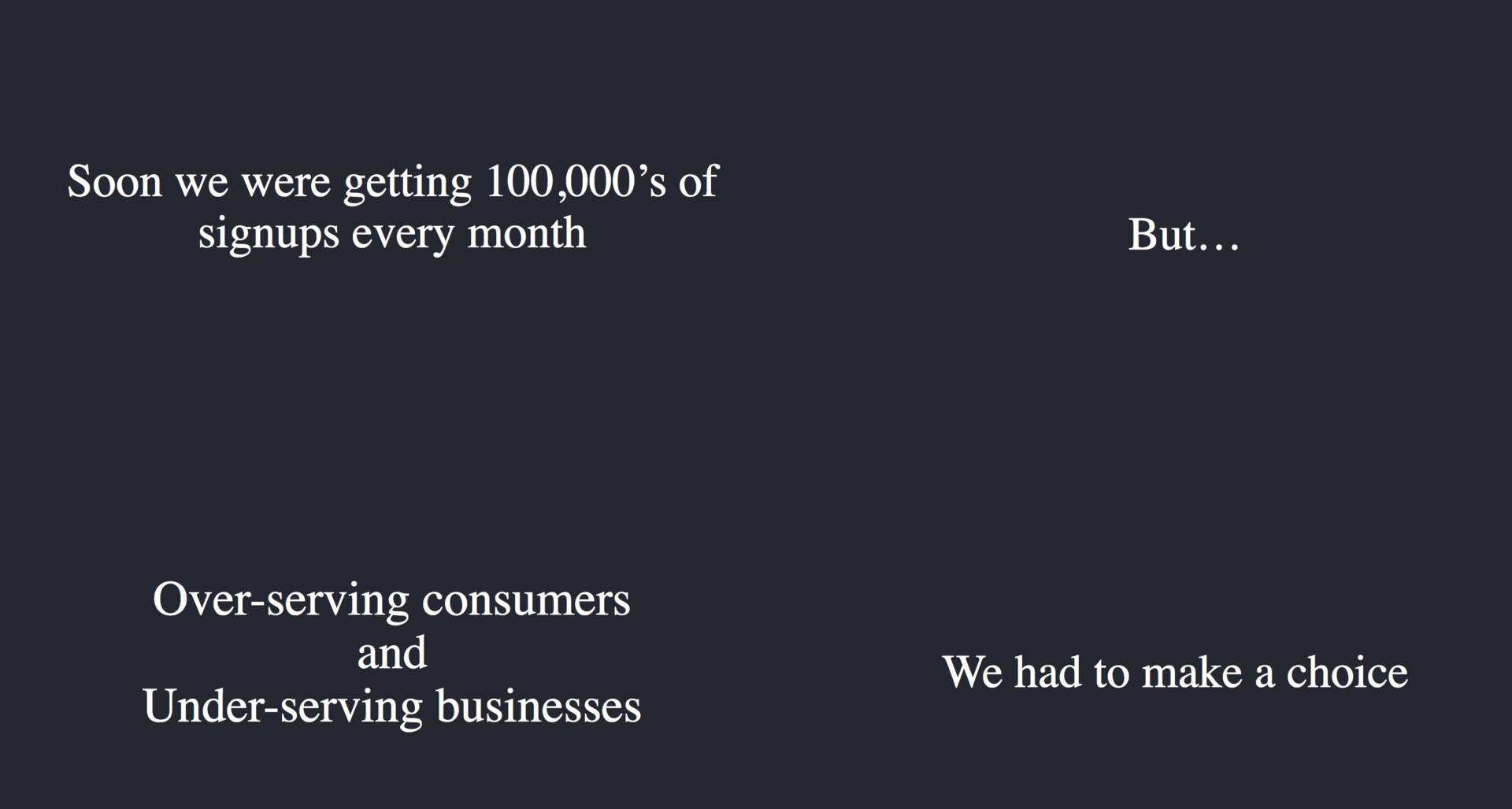
As for the organizations, the protection of information was insufficient, and we did not have the opportunity to allow them to store their data with us. Therefore, it turned out that our service provided unnecessary features to the average user, and did not have the necessary functions for organizations. We were in a difficult position. We were in a period when it is very difficult to determine what we want from our business. We had to make a choice. We were at a fork, and it was necessary to decide which way to go.
All this happened somewhere in the second half of 2006. When we dropped out of college, I was 23, and my co-founder was 22, and our team was even younger. In 2006-2007, we saw two paths, and the worlds to which these paths led were very, very different. When you create a startup to work with consumers, it is mostly fun and exciting: you often go to parties.
While working with organizations you are constantly struggling, because such a business model is rather ungrateful: most often people hate corporate software. Somehow we imagined these two paths, and we had to choose from these two worlds. We looked at them and weighed. Well, working with consumers looks pretty fun, and working with organizations looks very complicated and full of tests, but at the same time, in the consumer sector, you are always struggling to make money. You are trying to get people to pay for the product. Only two business models are used in this area.
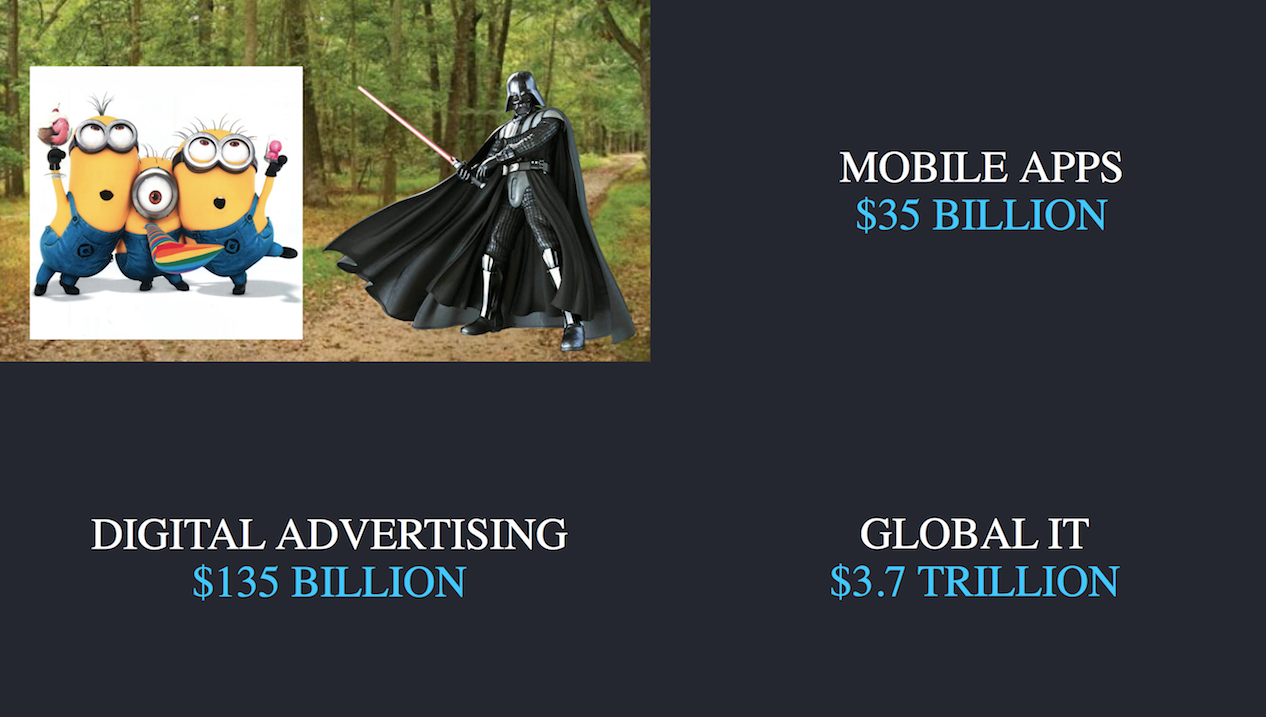
You can offer people to buy the application or you can make money from advertising. To give you an idea of this, here are a few relevant figures. In the b2c segment, about $ 35 billion is spent on mobile applications around the world per year. Pretty big number, right? 35 billion dollars!
And the global market for digital advertising is estimated at 135 billion dollars. So if you are not involved in e-commerce, then within the framework of the b2c model, you are aiming at these 170 billion dollars from the sale of applications and advertising. Such a large figure opens up many possibilities.
However, in the b2b segment, $ 3.7 trillion is spent on technology every year. This amount includes expenses for servers, infrastructure, software, networks and services. All this mass of technology equals several trillions of dollars a year. We realized that there is a rather big difference between the two markets.
[If we chose the first option, we would have to] fight to get people to pay a few dollars a month for a service that Google, Microsoft and Apple will try to make free after a while. At that time, there were rumors that Google Drive was preparing to go out, and other products behind it. But in the corporate segment they don’t save money on information technology, everyone is trying to increase productivity and try to expand the business, and therefore the relation to [IT] values is very different here.
In the consumer sector, we have a limited amount of money that we want to save, and therefore our task: to get as few things as possible on them. In the corporate environment, the question is posed differently: “What will this technology bring to me? How profitable is it for me? ” This important point should be considered when making a decision.
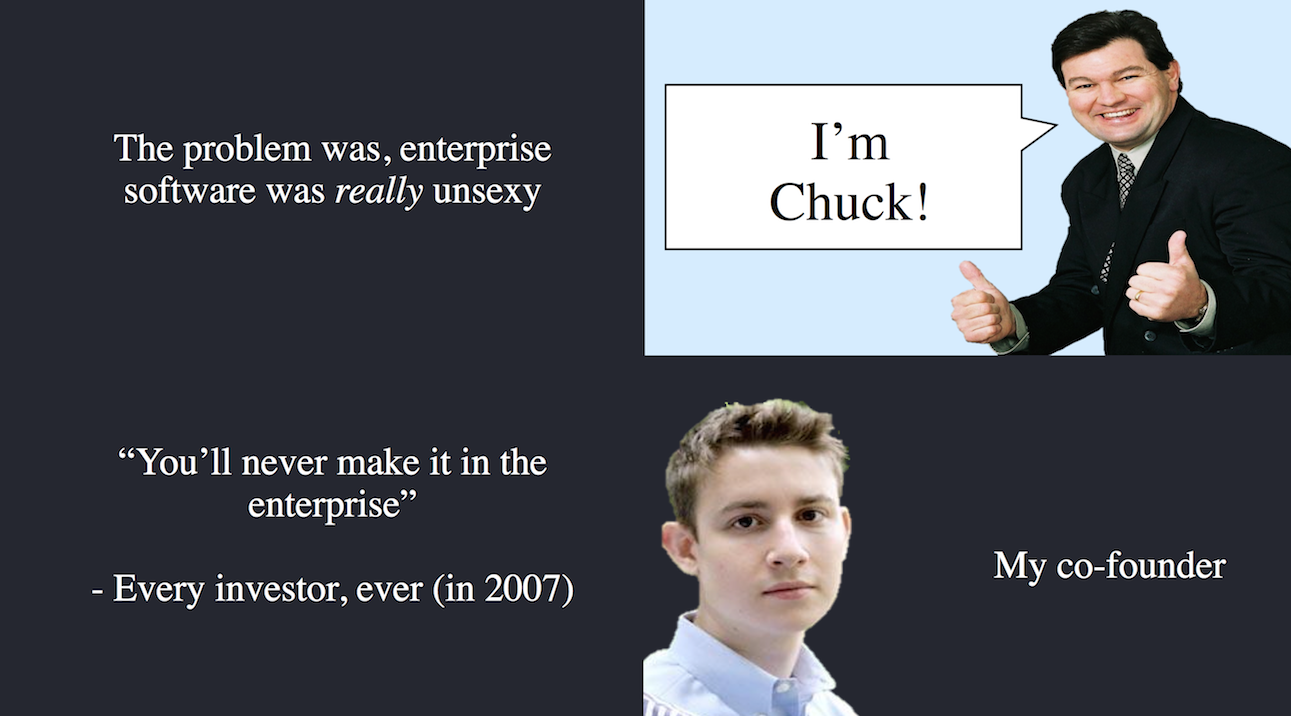
However, the problem was that the prospect of creating enterprise software was very unattractive. This is an area of activity with very high competition, in which it is difficult to build a business.
No one jumps out of bed with a little morning with the thought: “I want so much to build a company for the development of enterprise software!”
And the reason for this is incredibly simple, as it always has been: such software is created incredibly long. This is a slow process, because in this environment you cannot make money on advertising, and sales take a long time, because customers are reluctant to acquire technology. I think everyone knows the widespread belief that when you try to sell enterprise software, you have to spend several years convincing a company to buy it from you. Then it will take several more years to introduce the technology as a priority [in the company]. Many companies for many years create products that are not used anywhere else as the main ones.
We feel that this is a huge problem, and we would not want to get involved in it. The technology itself is not an easy thing; I don’t know how many people had to use corporate software, but such software is really complicated. You’re trying to understand why, for the sake of design, the designer placed 47 buttons on one page, and you can’t even imagine why this is done in this way.
I will answer this question in just a second. Usually, creating such software, developers do not care about the design and amenities of the client, do not treat the project with love, and it turns out just a complex product. If it seems to you that everything is still not so bad, think: how are you going to sell the developed software?
To anyone who loves the Internet and its capabilities, the idea of having an intermediary for sales may seem unattractive. You are forced to hire a bunch of people in every country who will be the only link between you and the client.
You hire a guy named Chuck , Chuck takes his portfolio and leaves to try and sell a lot of corporate software to customers. To clarify, this is how Chuck looks [slide]. This is how the sales process looks, at least how you (at least at the company) and we present it. Chuck looks happy, but he's just a middleman anyway. Why don't we resort to the power of the Internet and spread our technology this way?
Why do we have to put up with reseller sales to expand our business? The next few minutes we will devote to why our ideas about the sales process were incorrect. We were scared already, and then there were investors who in 2007 said that we had no chance of working with organizations.
“You recruited a team of 20-year-old boys, and you do not have a single person who would work in big business. Microsoft, Oracle, IBM - these companies will crush you. It will be very, very difficult for you to succeed, ”is what we were told.
In fairness, I’ll say that they turned out to be right to a certain extent. We were a very inexperienced team and were just starting our career. For example, my co-founder looked like he was 13 years old, like this [slide].
Does that kind of matter? This is he, our financial director, and here, I think, he is about 29. But we looked like we were going to take all the money and go to Disneyland. I understand why everyone believed that we would not pull. I can’t imagine myself in the place of a man who will give him money.
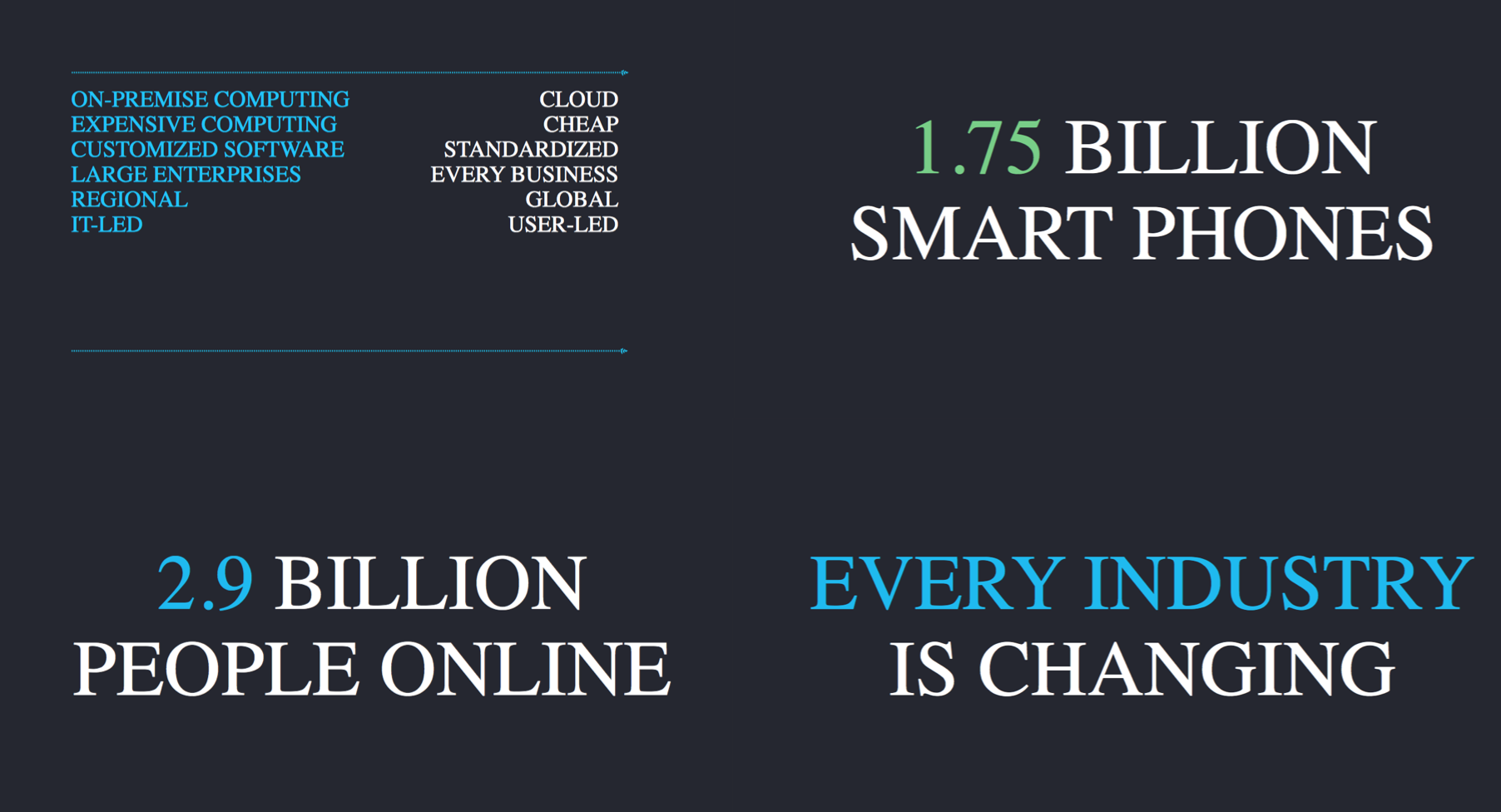
We decided that we should do it anyway. We decided that we should give all our best and were going to use our scaling capabilities, the client experience created by us, the very essence of our company and see if we can apply all this in the corporate environment.
We are very lucky. There was an investor who was just starting his career, who believed in us because at the time there were some changes in the corporations that could provide us with an advantage. We decided that if we are going to make a large company, if we are going to work with a large business, we must learn to play by the new rules.
It was decided to make large companies our customers and create software for them, and it was clear that we would have to play by completely different rules. Can software be made easier? Is it possible to change the long selling process? How do we learn to sell our product directly instead of using a chain of intermediaries? How to create a design for the end user, and not just follow customer requirements?
With regard to most of these issues, we decided to act in the exact opposite of what the rest of the corporate software market players did. We were going to understand what has changed in the technology world to build a new and better software company. This is the decision we made, and this is why we aimed at corporations - this is the path we took 8 years ago.
I repeat, today about 240,000 enterprises work and use our product with us. This is because we developed a business model, developed software and developed a solution for working exclusively with enterprises, and it turned out what we had in mind. I’ll go a little deeper into the story of what has changed in the world, and on the basis of which we created the company.
And here is what I highly recommend:if you are creating an enterprise software development company, then focus on your own technology. In part, this played a role in making decisions, helping us to challenge problems.
Over the past five years, much has changed in enterprises, as well as the software used. If there is an opportune time to create an enterprise software development company, then this time has come, given how many changes are taking place in organizations.
Let's walk through a couple of them.
Firstly, most application development companies are switching to cloud services. If you were planning to create an enterprise business management company, an enterprise intellectual property management company or even a communications management company several years ago, then you would have to ensure the availability of the service in every country and every city where there are customers. It doesn’t matter how large your client base is, no matter in which region, a separate data center should be created for each client.
This is a disadvantage of separate processing - you would have to do extra work, hire extra labor, which slowed down the whole process of software development and its launch in the enterprise. Suddenly, a “cloud” appeared, and services like SalesSource.com and Amazon Web Services spoke their word.
They wondered why every customer who wants to install a pair of servers should connect them himself, connect them to a data server with a network and ensure security so that after 6 months they “come to life” and the developer can use them in the organization? Why does the same thing happen with applications? Why is this the place to be today? We can simply combine tens of thousands of servers and give them to work on demand, so that you can use them for whatever you want and when you want. We can do it. Obviously, this has become the definition of cloud computing.
As a result, IT directors and large companies have benefited from this. For everyone who sits in this class, it’s clear that when you create your own company, you don’t buy your own servers; instead, you use Google, Yahoo! or Ashore. But corporations with many years of infrastructure are forced to move to the "cloud" only now. This is such a massive transition.
We are moving into the world of cheap computing on demand, from the world of expensive computing. The advantage of creating a startup is that the consumer market is not inert, buyers are always ready to adopt new technology. As the cost of computing drops, it becomes easier to make and use new decisions. This means that the barrier to reviewing and presenting technology at the corporate level is reduced, which is great for startups.
We are moving from the world of specialized platforms to the world of software standardization. Once you had to configure the software yourself so that the client was satisfied, but now customers understand that they can configure the interface themselves without looking inside the tool complex.
It was like, creating corporate software, you could sell it to only 5-10 thousand of the best companies in the world, because only these companies have the means and infrastructure to cover the costs of technology and implement them in the enterprise. Today, companies consisting of two people (literally) can use Box, and we also work with General Electric, which employs more than 300 people.
The fact that you can serve small companies around the world along with the largest on the planet means that you can enter much larger markets.
And reaching a level higher than enterprises is a very profitable economic project. The platforms themselves are becoming more global - our customer community has become international a couple of weeks after the start of the company. If you create enterprise software according to the usual canons, then it will take several years.
Finally, the most dramatic change is with mobile devices. iPhones and smartphones running Android, iPad tablets and other information technologies have become much more accessible to users. This is fundamentally important.
In the world of information technology, large companies usually win because they already have connections with organizations and their directors for information technology, they are familiar with demand and know which product is in demand. Today, users themselves are introducing technology. They begin to use them themselves in the sales department, in the marketing department, in the financial fields, and you can already create software based on this. This means that company employees can start using enterprise software, and later, you can sell it to the company when they need better control, better protection and scalability.
So, you still have the same business model for enterprise software development company, but today, the path to product implementation in the enterprise lies throughend user .
There are more than 2 billion smartphones on the planet . Just 10 years ago, if you managed the technical facilities of the company, then you were dealing with a network of computers located inside the building. But now, with billions of smartphones, you have to deal with a huge amount of computer technology that works at any time and on any network. This is an important point for software companies, because not a single large enterprise that has existed for a long time has the technology that can support this line of work and this way of managing data. This opens up great opportunities for startups.
Nearly 3 billion people work online. In this regard, changes are occurring in all industries, and each enterprise is changing its views on how to sell its goods to consumers. A technological revolution in an enterprise can occur for just two reasons.
The first reason is a change in raw materials. The cost of computing falls, they are centralized, and people use them as needed. The second reason, which entails changes: if people who buy the company's products will need new experience in use, in addition to this product. Let me give you an example. If you are planning to travel anywhere from campus, then you will probably use something like Uber or Lift. Whether you're into the forwarding business, or the shipping business, Uber will make a huge difference in your industry. You cannot allow Uber to exist without realizing what consequences it will lead. What will be the consequences of Instacart? What will the use of Lift lead to in my business model?
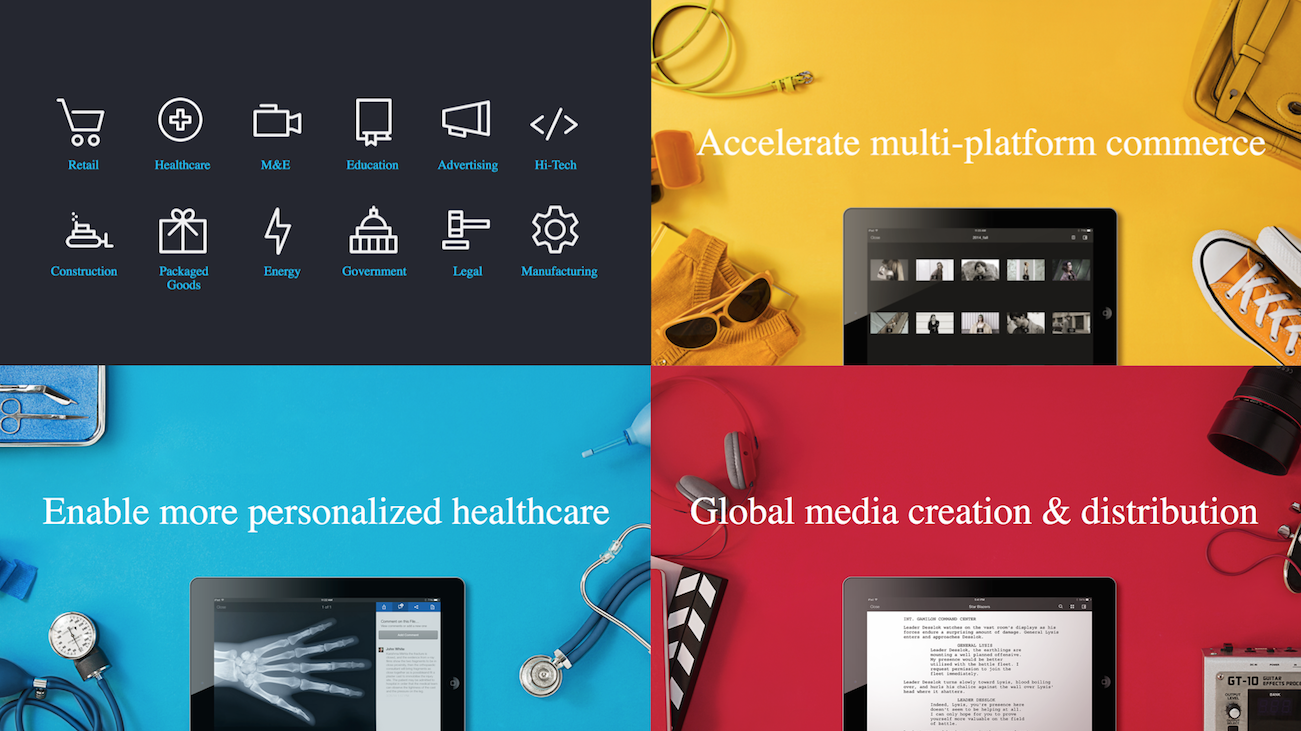
Thus, in a world where corporations are facing such changes, you will need new technologies to help them create a business model and adapt to technological gaps of this kind. That is why now is such a wonderful time to create specialized enterprise software development companies. Now every industry is going through technological gaps in the business model, which means that they will need start-up technology to bridge these gaps.
Let me give you a couple of examples: in retail, there is the term multifunctional or multichannel commerce. You would like to make purchases on the Internet, in a store or by phone, and you do not mind if the goods you bought are delivered to your home. Most market technologies do not support multi-channel commerce. Most organizations were not ready, which means that when buyers want to buy goods anytime, anywhere and get complete information about a product, then every seller in the world will need a technological complex to support retail.
Every healthcare institute is trying to find a way to create a personalized approach. Health care wants to restructure medicine into personal relationships. The business model of healthcare is shifting towards the reception of patients and conducting examinations, where the client pays for his well-being and for staying healthy. And all of a sudden, every healthcare institute needed technology to expand the capacity to care for the sick.
They want to introduce telemedicine in order to provide medical care in regional departments, and not just in a single hospital hospital. So there are new options for implementation: how will healthcare providers interact with each other so that the doctor can make better decisions? To make all of these things possible, you need new software.
The next example is media space. Whether it’s television, music, or movies, this business model focuses on a linear supply chain. After the release of the film, he goes to the cinema for 3 months, then he gets on iTunes or other platforms where people can purchase it at will. But distribution methods will change, given that 3 billion people are currently online. There is no media network that has a platform capable of backing up data, information and other content entering the system on such a scale.

Just yesterday, I was in Los Angeles, where I met with a media company that conducted an analysis to identify my potential moviegoers among three billion users. They want to target three billion fans of films of certain genres. And please, here is a film company that needs to conduct intellectual analysis and marketing of a large amount of data to enter the market and distribute products.
Where the two industries merge together, new software is simply needed. Each industry faces its own challenges. You can choose any niche that you like, take a closer look at it and name the main technological factors that can change the business model over the next couple of years. Software will be required to cope with these industry changes. Think about the future of water, who can control it? I'm sure you need software.
The advantage of our stay at Stanford is the ability to learn technology. And we believe that the high-tech industry is also an industry. But what really happens? Each industry will introduce technological elements into its field of activity, since corporations will not survive in the future if they do not apply modern technologies. If they are not able to use the data themselves and use new tools, then they will begin to work with the so-called high-tech industry.
Over the next 5-10 years, there will be many partnerships when companies need technology to become smarter, faster, and to do their job safer. This will not only change how a person will work in the enterprise, but will completely change the business models of these companies. On this I will finish the second part.
Now I will give practical tips to facilitate your start. To be honest, most of these tips need to be passed through the prism of retrospective, which means that everything will go completely different from what I say, but looking back, I can say that these are the things that led us to success. It is difficult to give specific recipes when talking about building a company. You may not understand everything, but it will give you a basic understanding of how to build an enterprise software development company.
The very first tip is to notice technological gaps. This advice is useful for companies working both with enterprises and with ordinary customers.
Other tips are more focused on creating software for organizations, but they are fundamental to building a technology company.
You should look for new high-performance technologies or the main areas in which there is a huge gap - the gap between how things are done and how they could be done. Looking back at our own business, we understand that such a gap was the complexity and burdensome process of file sharing, while there was a reduction in the cost of disk space, faster Internet and better browsers.
Looking at the corporate sector, we ask the following questions. What can they do with their data when the cost of computing drops so fast? What does this affect from a business perspective?
What was impossible to create 10-15 years ago due to economic inexpediency or technical impracticability is now possible. A funny thing that can be done at any time, if you find the headlines of a newspaper from the 1990s or 1980s and browse business articles about technologies, you will notice that what we are creating today is a remix of the technologies that people tried to create 10, 20, 30 years ago.
Then it was either too expensive or too complicated, or we did not have the necessary resources. You can watch how concepts come to life - that which was impossible 5 or 10 years ago is now used everywhere. I will give you an example. There is a company called PlanGrid, does anyone know what PlanGrid is doing? Got it, good. Are you in the construction industry? You? Oh my God! What would that mean?
This is great. In essence, PlanGrid is a mobile application that allows you to manage construction projects, providing access to drawings, and other data related to the construction process. I think the creators of the company realized that every year they spend about $ 4 billion on printing drawings. And with the help of their product they provided customers with access to all printouts, updates and all changes to the drawings at any necessary time, and they also provided the opportunity to view the lists of contractors and builders.
They suddenly realized that the iPad is an excellent device for viewing drawings and other significant information, displaying even a small, minute change in a particular process. This idea can change the construction industry, which is not very familiar with high technology, except perhaps from the design side.
How to create a technology that easily solves the problem of data coordination? How to create technology that is easy to implement in an industry that has not changed for a long time? PlanGrid combined the solution of these problems in itself and became an incredible discovery for a changing market. Then this team launched a startup to solve the problem, did it very well and took over the construction industry.

The next important point in working on enterprise software is working on small projects. By this, I mean that you need to find a natural wedge, that is, create a product that would “ wedge ” and fill in the gaps in existing products.
This tip is suitable for all companies engaged in a corporate environment (with a small number of users). This little product that you come up with will grow over time and become an integral part of the enterprise structure. All you need to do at first is say: “We will deal with this part of the problem, but you will get incredible experience from using our product. We are also going to change the business model and create a new technology that will very simply solve the problem. ”
At first, it may seem that the project is small, but perhaps you will begin to grow further. You will not be able to compete with those who have long been working in the market, and they always aim at a comprehensive solution to the problem. You will need to find significant deficiencies in the solutions they offer, so that the buyer wants to resolve them using third-party technologies. And over time, the number of use cases for your application will increase, and you will reach larger buyers.
ZenPayroll , founded by Stanford alumni a couple of years ago, is a great example . They found that managing payrolls for small businesses is a complex and incredibly annoying process.
You could not receive a check about your payment by e-mail, see the schedules of your salaries, etc. There was not a good enough solution to this problem. And the guys from ZenPayroll said:
“We will infiltrate the existing structure and deal with the piece that is most difficult to start with: the problem of hiring people and giving them wages. We will deal only with this one process of maintaining payrolls, but we are going to make it deadly simple. "
After some time, they got the opportunity to rise in the market and provide new opportunities. Large companies in the market look at startups like ZenPayroll and say that they are small, and their product is suitable only for small businesses, how can they be quite competitive? But this is only the beginning, as soon as they enter the market, they get the opportunity to expand after some time, adding more services and opportunities, for this you just need to find the right and correct technological gap, on the basis of which the company should be built.
In the next step, you need to find the weaknesses of large companies.
You need to highlight what they cannot or do not want to do on the market, due to economic or technical considerations or due to a somewhat unusual way of implementation. I will give you two tips.
Today, if you are going to create enterprise software for large organizations, then use an oriented approach. You need to create a technology that is not tied to any platform. Software developers want everything to be integrated with each other, and such integration can benefit greatly, but you need to move in a different direction. You need your technology to work on all platforms, this way you can work with a large number of different clients.
You can interact with so many different platforms that a large company is unable to work with - this is technically impossible for them because of their architecture or the fundamental components of a business model that do not take such behavior into account.
The second tip is to try to do things that are economically beneficial. A business model is the foundation of the company, and you can look at its structure and understand where there is no way to reduce prices. Another option is to find ways to make money on the company's customers. Such [methods] that no one has found before you, which will make the use of such a method unacceptable to anyone else.
There is a company called Zenefits, which owns another HR management company and helps you small startups manage profit and HR information. Instead of starting a startup that might not have brought profit due to the low level of software, they decided to take a commission from insurance companies that pay for the opportunity to use this software. The client himself does not pay for Zenefits - insurance companies pay. The guys came up with this business model, which other companies did not think of or dared not apply. They changed the balance of power in a category that affects the performance and effectiveness of small businesses. For a long time there was no innovation in this niche.
Next, you need to find the craziest, but still rational ideas in the client ecosystem. You need to find customers who are on the verge of creating a business, business model, industry and determine their unique characteristics in order to start from this. This is an easy way to identify trends and patterns of change. These tips apply in practice. If you find customers who are looking to the future, then you can work with them and find something that they will miss.
There is a company called Skycatchproducing industrial drones. At first glance, this seems strange, but in the manufacturing sector and in agriculture, aircraft are used for data collection and modeling. Skycatch understood the most advanced technologies in their field and worked with a decent number of companies that welcome the introduction of new products. Thanks to this, Skycatch became the first company producing b2b-drones.
The idea is this - look at your market. Find customers at the forefront of your market who use technology to take a leading position, and use these technologies to improve the performance of your product. When working with them, look for ways to develop your product.
Listen to your customers, but don't always follow what they tell you.
This is a very important point to consider when developing enterprise software. Clients will make a very large number of proposals, and your task is to gradually introduce them into the product, but this does not mean that you must create exactly what they say. Your task is to hear what they are telling you and decide which function is worth introducing, and how easier it is to do it. Palantir is a good example of how to give simple answers to very complex questions that the client would never have thought of.
You need to simulate, not modify, by order of the client, which means creating a platform embedded in the software.
Make sure you don't forget about openness and software interfaces as a way to work with user experience. The great thing about enterprise software development is that today its foundation is user data. This facilitates the implementation, and hence the sale to organizations.
Make sure that you always bring a piece of custom ideas to the product - it must sell itself. But this does not mean that you do not need sales specialists. This is a very significant point.
Use everything that you find yourself and what users can tell you to get customers. But you still need sales specialists to help users familiarize themselves with the product, understand the competitive environment and ecosystem. At the same time, your sales partners should not become an obstacle to the creation of an excellent product. All this means that you are starting to create a product within the company.
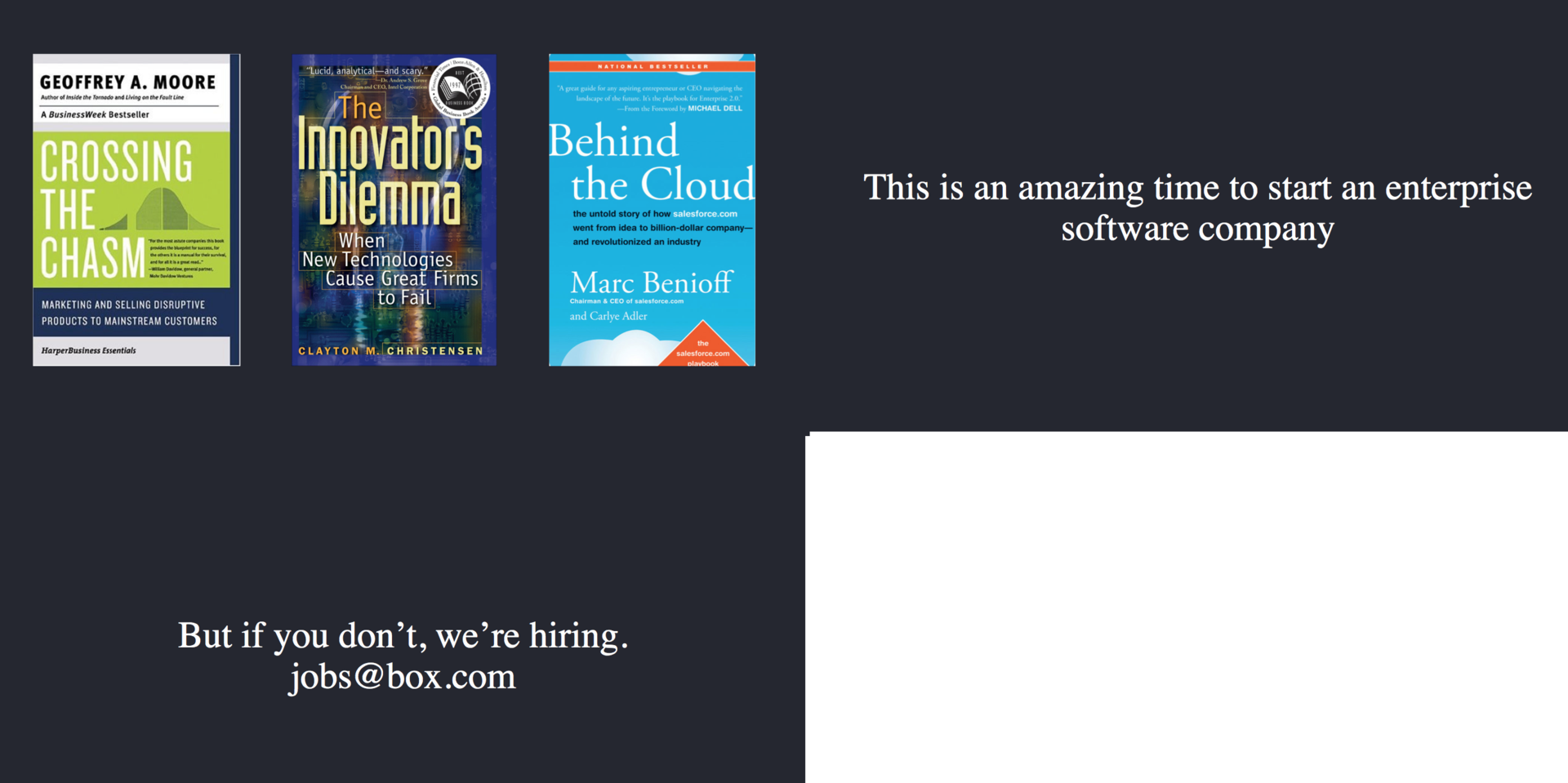
Thus, in conclusion of today's lecture, I would like to recommend these books and say that now is a great time to create an enterprise software development company. I wish you good luck. If something doesn’t work for you, then pay attention to our vacancies. The only thing, please do not compete with me, I already have enough competitors. Ideally, either work with us or build your own company.
Thank you very much for your attention!
